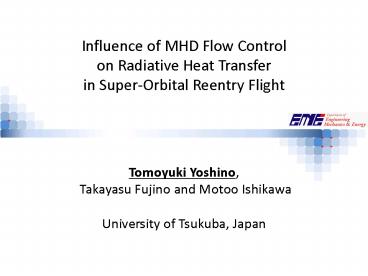Influence of MHD Flow Control - PowerPoint PPT Presentation
1 / 37
Title:
Influence of MHD Flow Control
Description:
on Radiative Heat Transfer. in Super-Orbital Reentry Flight. Tomoyuki Yoshino, ... Reduction of convective heat transfer. Applying magnetic field. Objective ... – PowerPoint PPT presentation
Number of Views:59
Avg rating:3.0/5.0
Title: Influence of MHD Flow Control
1
Influence of MHD Flow Control on Radiative Heat
Transfer in Super-Orbital Reentry
Flight Tomoyuki Yoshino, Takayasu Fujino and
Motoo Ishikawa University of Tsukuba, Japan
2
MHD Flow Control
Applying magnetic field
Reentry
Reduction of flow velocity in shock layer
Increase of shock standoffdistance Reduction of
convective heat transfer
3
Objective
- Palmer() suggested probability that expansion
of shock layer by applying magnetic field led to
increase in radiative wall heat flux. - No studies have carried out on numerical
analyses for MHD flow control considering
radiative wall heat flux.
To investigate influence of expansion of shock
layer by MHD flow control on radiative wall heat
flux under condition of super-orbital reentry
flight
() Palmer G. Magnetic field effects on the
computed flow over a Mars return aerobrake, J.
Thermophysics and Heat Transfer, Vol. 7, No. 2
(1993), pp. 294-301.
4
Numerical Method for Plasma Flows
2-D computational magnetohydrodynamic analysis
Eleven chemical species N, O,
N2, O2, NO, N, O, N2, O2, NO, e- Parks
chemical kinetic model Parks two temperature
model Ttr Translational-Rotat
ional Temperature Tve
Vibrational-Electronic-Electron Temperature Low
magnetic Reynolds number model including Hall
effect
5
Assessment of Radiative Wall Heat Flux
Structured package for radiation analysis
SPRADIAN()
- SPRADIAN obtains emission coefficients by
considering - bound-bound (N2, O2, NO, N2, N, O, N, O)
- bound-free (N, O, O)
- free-free (N2, N, O, N2, O2, NO, N, O)
- radiations.
- And then, radiative wall heat flux is calculated
by integration of radiative transfer equation all
over shock layer.
Fujita K., and Abe T. SPRADIAN, Structured
Package for Radiation Analysis Theory and
Applications, ISAS Report No. 66, 1997.
6
Numerical Conditions
Magnetic field distribution
Flight condition (MUSES-C reentry 64 km)
7
Distributions of Static Pressure
MHD on (0.3 T)
MHD off
22,000
12, Pa
8
Radiative and Convective Wall Heat Flux
Convective wall heat flux and total wall heat flux
Radiative wall heat flux
5 up
64 up
29 down
9
Radiation Density toward Stagnation Point
Line spectra emissions of N and O atoms
10
Radiation Density toward Stagnation Point
11
Temperatures along Stagnation Line
12
Chemical Composition along Stagnation Line
MHD off MHD on (0.3 T)
Neutral species
Ionic species
Chemical composition is no altered by applying
magnetic field.
13
Mass Fraction of Nitrogen Atomic Ion (N)
MHD off
MHD on (0.3 T)
0.15
0
Applying magnetic field leads to increase in
monatomic ion species. decrease in neutral
species and molecules.
14
Radiation Density toward Stagnation Point
Continuous spectra emission of N
N
N
N
15
Conclusions
- Radiative wall heat flux is significantly
increased by applying MHD flow control. - The main factor of increase of radiative wall
heat flux is increase in emission area due to
expansion of shock layer. - At stagnation point, convective wall heat flux
with magnetic field of about 0.3 T decreases by
29 and radiative wall heat flux with magnetic
field increases by 64 compared to those without
magnetic field. As a result, total wall heat flux
with magnetic field becomes 5 larger than that
without magnetic field.
16
(No Transcript)
17
Radiation Density toward Stagnation Point
18
Radiation Density toward Surface Point of
Downstream Wall
19
Configuration of MUSES-C and Computational Grid
20
Mass Density of Mixture Gas
21
Spectral Distribution of Emission Coefficient
22
Spectral Distribution of Emission Coefficient
23
Spectral Distribution of Emission Coefficient
24
Spectral Distribution of Emission Coefficient
25
Spectral Distribution of Emission Coefficient
26
Spectral Distribution of Emission Coefficient
27
Basic Equations for Gasdynamics
Mass conservation equations
Convection terms ? AUSM-DV scheam
(N,O,N,O,N2,O2,NO,N2,O2,NO,e-)
Parks Two-Temperature Model
Momentum conservation equations
11 Chemical Species and Parks chemical kinetic
model
Total energy conservation equation
Vibrational-electronic-electron energy
conservation equation
28
Basic Equations for Electrodynamics
Steady Maxwell Equations
The generalized Ohms law
Galerkin finite element method
29
Previous numerical studies Relations
between drag and altitude
Future Work
30
Relations between flight velocity and flight
altitude
Future Work
Externally applied magnetic field dipole magnet
We will examine influences of MHD flow control
utilizing real air-core circular magnet on the
flight trajectory and aerodynamic heating.
31
Distribution of Externally Applied Magnetic Field
The present study varies the value of the
parameter B0 over a range of 0.0 to 0.5 T.
32
Magnet Conditions
Rmag
L Self inductance I Coil current
Basic Equation for Externally Applied Magnetic
field
Biot-Savart law
33
The case to increase wall heat flux(altitude 71
km, coil outer radius 0.2 m)
Flight condition Altitude 71 km Velocity 7.0
km/s
reattachment point
cyclic domain
Wall heat flux
Stream line for plasma flow
Excessively and locally strong magnetic field
generates cyclic domain.
34
Magnetic field distribution
In the case of relatively large magnet (Rmag0.8)
Blunt body with large radius of curvature
Blunt body with small radius of curvature
35
Relations between Maximum wall heat flux
and magnet outer radius
36
Distribution of Lorentz force
71km
59km
12000
N/m3
Rmag0.6
Rmag0.6
0
37
Distribution of Wall Heat Flux
(Altitude 63 km)
Freestream condition Pressure 14.0
Pa Temerature 237.1 K Velocity 6.2 km/s
(Altitude 63 km)































